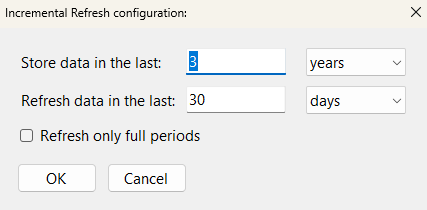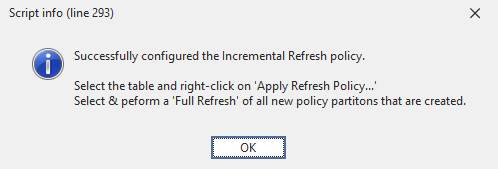Configure Incremental Refresh
Script Purpose
If you want to configure Incremental Refresh for an import table based on a specific date field.
This script will work for datetime, date, or integer date columns for which you want to configure incremental refresh.
To use the script, select the date column in the table for which you want to configure incremental refresh, then run the script. The script will only run if you don't already have a #"RangeStart" and #"RangeEnd" parameter, and the selected table doesn't already have a Refresh Policy configured.
Note
This script will automatically modify the M partition of the table to add the filter step. Be sure to check that this was done correctly.
If you have many steps you must be sure to move this step to a point when it will fold to the data source. Make sure you adjust all the `#"Step References" in Power Query
Note
This script uses user input to generate the refresh policy. Make sure you enter the correct values in the user input dialogue box.
Script
Implement Incremental Refresh for Selected Column
// This script will automatically generate an Incremental Refresh policy for a selected table
// It is generated based on the selected column
// It requires input from the user with a dialogue pop-up box.
// This script will automatically generate an Incremental Refresh policy for a selected table
// It is generated based on the selected column
// It requires input from the user with a dialogue pop-up box.
using System.Drawing;
using System.Windows.Forms;
// Hide the 'Running Macro' spinbox
ScriptHelper.WaitFormVisible = false;
// Initialize Variables
Table _Table = Model.Tables[0];
string _MExpression = "";
Column _Column = Model.AllColumns.ToList()[0];
string _ColumnName = "";
DataType _ColumnDataType = DataType.DateTime;
try
{
// Select a Table for which you will configure Incremental Refresh.
// The Refresh Policy will be enabled and configured for this table.
_Table =
Model.Tables.Where(
// Exclude tables that already have a refresh policy
t =>
t.EnableRefreshPolicy != true &&
// Include only 'Table' objects
t.ObjectType == ObjectType.Table &&
// Exclude Calculated Tables
t.Columns[0].Type != ColumnType.CalculatedTableColumn &&
// Only include tables that have a column on the "From" side of the relationship
(Model.Relationships.Count() > 0 ?
t.Columns.Any(c => Model.Relationships.Any(r => r.FromColumn == c) ) : true) &&
// Exclude tables that don't have a DateTime or Integer column
(
t.Columns.Any(c => c.DataType == DataType.DateTime) ||
t.Columns.Any(c => c.DataType == DataType.Int64)
)
).SelectTable(null,"Select a Table for which you will configure Incremental Refresh:");
_MExpression = _Table.Partitions[0].Expression;
try
{
// Select the column to apply the Refresh Policy.
// The M Expression will be modified using the name of this column.
_Column =
_Table.Columns.Where(
// Include only DateTime or Int columns
c =>
c.DataType == DataType.DateTime ||
c.DataType == DataType.Int64
).SelectColumn(null, "Select a DateTime or DateKey (Int) Column to apply the Refresh Policy.");
_ColumnName = _Column.DaxObjectName;
_ColumnDataType = _Column.DataType;
try
{ // Test if 'RangeStart' exists
Model.Expressions.Contains(Model.Expressions["RangeStart"]);
Info ("RangeStart already exists!");
}
catch
{
// Add RangeStart parameter
Model.AddExpression(
"RangeStart",
@"
#datetime(2023, 01, 01, 0, 0, 0) meta
[
IsParameterQuery = true,
IsParameterQueryRequired = true,
Type = type datetime
]"
);
// Success message for adding 'RangeStart'
Info ( "Created 'RangeStart' M Parameter!" );
}
// Test if the RangeEnd parameter exists
try
{ // Test if 'RangeEnd' exists
Model.Expressions.Contains(Model.Expressions["RangeEnd"]);
Info ("RangeEnd already exists!");
}
catch
{
// Add RangeEnd parameter
Model.AddExpression(
"RangeEnd",
@"
#datetime(2023, 31, 01, 0, 0, 0) meta
[
IsParameterQuery = true,
IsParameterQueryRequired = true,
Type = type datetime
]"
);
// Success message for adding 'RangeEnd'
Info ( "Created 'RangeEnd' M Parameter!" );
}
// Incremental Refresh Configuration
// Input box config
Font _fontConfig = new Font("Segoe UI", 11);
// Label for how long data should be stored
var storeDataLabel = new Label();
storeDataLabel.Text = "Store data in the last:";
storeDataLabel.Location = new Point(20, 20);
storeDataLabel.AutoSize = true;
storeDataLabel.Font = _fontConfig;
// User input for how long data should be stored
var storeDataTextBox = new TextBox();
storeDataTextBox.Location = new Point(storeDataLabel.Location.X + TextRenderer.MeasureText(storeDataLabel.Text, storeDataLabel.Font).Width + 20, storeDataLabel.Location.Y);
storeDataTextBox.Size = new Size(100, 20);
storeDataTextBox.Text = "3";
storeDataTextBox.Font = _fontConfig;
// User selection for how long data should be stored (granularity)
var storeDataComboBox = new ComboBox();
storeDataComboBox.Location = new Point(storeDataTextBox.Location.X + storeDataTextBox.Width + 20, storeDataLabel.Location.Y);
storeDataComboBox.Size = new Size(100, 20);
storeDataComboBox.DropDownStyle = ComboBoxStyle.DropDownList;
storeDataComboBox.Items.AddRange(new object[] { "days", "months", "quarters", "years" });
storeDataComboBox.SelectedIndex = 3;
storeDataComboBox.Font = _fontConfig;
// Label for how much data should be refreshed
var refreshDataLabel = new Label();
refreshDataLabel.Text = "Refresh data in the last:";
refreshDataLabel.Location = new Point(20, storeDataLabel.Location.Y + storeDataLabel.Height + 15);
refreshDataLabel.AutoSize = true;
refreshDataLabel.Font = _fontConfig;
// User input for how much data should be refreshed
var refreshDataTextBox = new TextBox();
refreshDataTextBox.Location = new Point(storeDataTextBox.Location.X, refreshDataLabel.Location.Y);
refreshDataTextBox.Size = new Size(100, 20);
refreshDataTextBox.Text = "30";
refreshDataTextBox.Font = _fontConfig;
// User selection for how much data should be refreshed (Period)
var refreshDataComboBox = new ComboBox();
refreshDataComboBox.Location = new Point(storeDataComboBox.Location.X, refreshDataLabel.Location.Y);
refreshDataComboBox.Size = new Size(100, 20);
refreshDataComboBox.DropDownStyle = ComboBoxStyle.DropDownList;
refreshDataComboBox.Items.AddRange(new object[] { "days", "months", "quarters", "years" });
refreshDataComboBox.SelectedIndex = 0;
refreshDataComboBox.Font = _fontConfig;
// User input to refresh full periods or not
var fullPeriodsCheckBox = new CheckBox();
fullPeriodsCheckBox.Text = "Refresh only full periods";
fullPeriodsCheckBox.Location = new Point(storeDataLabel.Location.X + 3, refreshDataLabel.Location.Y + refreshDataLabel.Height + 15);
fullPeriodsCheckBox.AutoSize = true;
fullPeriodsCheckBox.Font = _fontConfig;
// Form OK button
var okButton = new Button();
okButton.Text = "OK";
okButton.Location = new Point(storeDataLabel.Location.X, fullPeriodsCheckBox.Location.Y + fullPeriodsCheckBox.Height + 15);
okButton.MinimumSize = new Size(80, 25);
okButton.AutoSize = true;
okButton.DialogResult = DialogResult.OK;
okButton.Font = _fontConfig;
// Form cancel button
var cancelButton = new Button();
cancelButton.Text = "Cancel";
cancelButton.Location = new Point(okButton.Location.X + okButton.Width + 10, okButton.Location.Y);
cancelButton.MinimumSize = new Size(80, 25);
cancelButton.AutoSize = true;
cancelButton.DialogResult = DialogResult.Cancel;
cancelButton.Font = _fontConfig;
// Adjust the Location of the storeDataLabel to align with the storeDataTextBox
storeDataLabel.Location = new Point(storeDataLabel.Location.X, storeDataLabel.Location.Y + 4);
refreshDataLabel.Location = new Point(refreshDataLabel.Location.X, refreshDataLabel.Location.Y + 4);
// Form config
var form = new Form();
form.Text = "Incremental Refresh configuration:";
form.AutoSize = true;
form.MinimumSize = new Size(450, 0);
form.FormBorderStyle = FormBorderStyle.FixedDialog;
form.MaximizeBox = false;
form.MinimizeBox = false;
// Open the dialogue in the center of the screen
form.StartPosition = FormStartPosition.CenterScreen;
// Set the AutoScaleMode property to Dpi
form.AutoScaleMode = AutoScaleMode.Dpi;
// Add controls to form specified above
form.Controls.Add(storeDataLabel);
form.Controls.Add(storeDataTextBox);
form.Controls.Add(storeDataComboBox);
form.Controls.Add(refreshDataLabel);
form.Controls.Add(refreshDataTextBox);
form.Controls.Add(refreshDataComboBox);
form.Controls.Add(fullPeriodsCheckBox);
form.Controls.Add(okButton);
form.Controls.Add(cancelButton);
// Draw the form
var result = form.ShowDialog();
// Get the values of the user input if entered
if (result == DialogResult.OK)
{
// Enables the refresh policy
_Table.EnableRefreshPolicy = true;
var storeDataValue = storeDataTextBox.Text;
var storeDataComboBoxValue = storeDataComboBox.SelectedItem.ToString();
var refreshDataValue = refreshDataTextBox.Text;
var refreshDataComboBoxValue = refreshDataComboBox.SelectedItem.ToString();
var fullPeriodsChecked = fullPeriodsCheckBox.Checked;
// Display the input values in a message box
var message = string.Format(
"Store data in the last: {0} {1}" +
"\nRefresh data in the last: {2} {3}" +
"\nRefresh only full periods: {4}",
storeDataTextBox.Text,
storeDataComboBox.SelectedItem.ToString(),
refreshDataTextBox.Text,
refreshDataComboBox.SelectedItem.ToString(),
fullPeriodsCheckBox.Checked);
Info(message);
// Convert StoreDataGranularity to correct TOM Property
RefreshGranularityType StoreDataGranularity = RefreshGranularityType.Day;
switch (storeDataComboBox.SelectedItem.ToString())
{
case "years":
StoreDataGranularity = RefreshGranularityType.Year;
break;
case "quarters":
StoreDataGranularity = RefreshGranularityType.Quarter;
break;
case "months":
StoreDataGranularity = RefreshGranularityType.Month;
break;
case "days":
StoreDataGranularity = RefreshGranularityType.Day;
break;
default:
Error("Bad selection for Incremental Granularity.");
break;
}
// Convert IncrementalGranularity to correct TOM Property
RefreshGranularityType IncrementalPeriodGranularity = RefreshGranularityType.Year;
switch (refreshDataComboBox.SelectedItem.ToString())
{
case "years":
IncrementalPeriodGranularity = RefreshGranularityType.Year;
break;
case "quarters":
IncrementalPeriodGranularity = RefreshGranularityType.Quarter;
break;
case "months":
IncrementalPeriodGranularity = RefreshGranularityType.Month;
break;
case "days":
IncrementalPeriodGranularity = RefreshGranularityType.Day;
break;
default:
Error ( "Bad selection for Incremental Granularity." );
break;
}
// Convert RefreshCompletePeriods checkbox to correct TOM property
int RefreshCompletePeriods;
if ( fullPeriodsCheckBox.Checked == true )
{
RefreshCompletePeriods = -1;
}
else
{
RefreshCompletePeriods = 0;
}
// Set incremental window: period to be refreshed
_Table.IncrementalGranularity = IncrementalPeriodGranularity;
// Default: 30 days - change # if you want
_Table.IncrementalPeriods = Convert.ToInt16(refreshDataTextBox.Text);
// Only refresh complete days. Change to 0 if you don't want.
_Table.IncrementalPeriodsOffset = RefreshCompletePeriods;
// Set rolling window: period to be archived
// Granularity = day, can change to month, quarter, year...
_Table.RollingWindowGranularity = StoreDataGranularity;
// Keep data for 1 year. Includes 1 full year and current partial year
// i.e. if it is Nov 2023, keeps data from Jan 1, 2022.
// On Jan 1, 2024, it will drop 2022 automatically.
_Table.RollingWindowPeriods = Convert.ToInt16(storeDataTextBox.Text);
// If the selected date column is an integer of type YYYYMMDD...
if ( _ColumnDataType == DataType.Int64 )
{
// Add DateTimeToInt Function
var _DateTimeToInt =
Model.AddExpression(
"fxDateTimeToInt",
@"(x as datetime) => Date.Year(x) * 10000 + Date.Month(x) * 100 + Date.Day(x)"
);
_DateTimeToInt.SetAnnotation("PBI_ResultType", "Function");
_DateTimeToInt.Kind = ExpressionKind.M;
// Source expression obtained from the original M partition
_Table.SourceExpression =
// Gets expression before final "in" keyword
_MExpression.Split("\nin")[0].TrimEnd() +
// Adds comma and newline
",\n" +
// Adds step called "Incremental Refresh" for filtering
@" #""Incremental Refresh"" = Table.SelectRows( " +
// Gets name of last step (after "in" keyword)
_MExpression.Split("\nin")[1].TrimStart() +
// Adds 'each' keyword
@", each " +
// Bases incremental refresh on current column name
_ColumnName +
// Greater than or equal to RangeStart
@" >= fxDateTimeToInt ( #""RangeStart"" ) and " +
// and
_ColumnName +
// Less than RangeEnd
@" < fxDateTimeToInt ( #""RangeEnd"" ) )" +
// re-add 'in' keyword
"\nin\n" +
// Reference final step just added
@" #""Incremental Refresh""";
}
// Otherwise treat it like a normal date/datetime column
else
{
// Source expression obtained from the original M partition
_Table.SourceExpression =
// Gets expression before final "in" keyword
_MExpression.Split("\nin")[0].TrimEnd() +
// Adds comma and newline
",\n" +
// Adds step called "Incremental Refresh" for filtering
@" #""Incremental Refresh"" = Table.SelectRows( " +
// Gets name of last step (after "in" keyword)
_MExpression.Split("\nin")[1].TrimStart() +
// Adds 'each' keyword
@", each " +
// Bases incremental refresh on current column name
_ColumnName +
// Greater than or equal to RangeStart
@" >= Date.From ( #""RangeStart"" ) and " +
// and
_ColumnName +
// Less than RangeEnd
@" < Date.From ( #""RangeEnd"" ) )" +
// re-add 'in' keyword
"\nin\n" +
// Reference final step just added
@" #""Incremental Refresh""";
}
// Success message for Refresh Policy configuration
Info (
"Successfully configured the Incremental Refresh policy.\n" +
"\nSelect the table and right-click on 'Apply Refresh Policy...'" +
"\nSelect & peform a 'Full Refresh' of all new policy partitons that are created."
);
}
else if (result == DialogResult.Cancel)
{
// if the user clicks the Cancel button, close the form and exit the script
form.Close();
Error ( "Cancelled configuration! Ending script without changes." );
return;
}
}
catch
{
Error( "No valid column selected! Ending script without changes." );
}
}
catch
{
Error( "No valid table selected! Ending script without changes." );
}
Explanation
This snippet will configure incremental refresh in the selected table based on a selected date column.
Example Output

